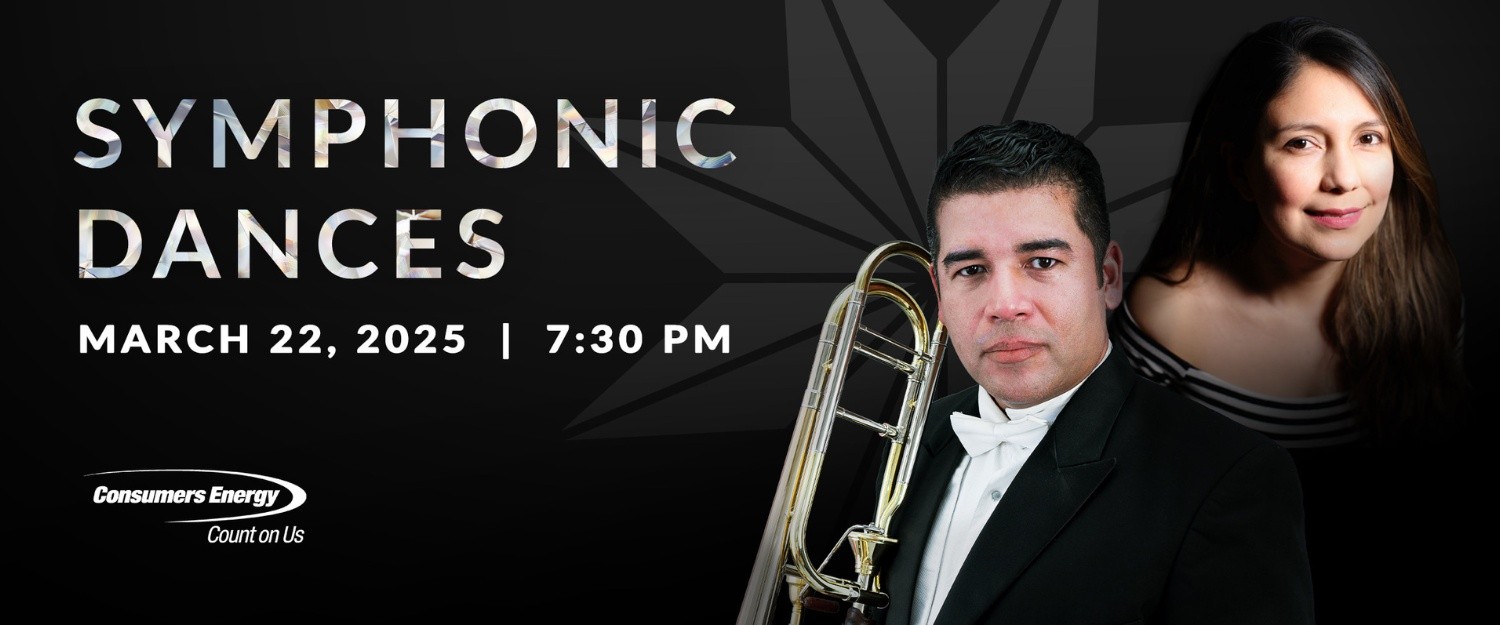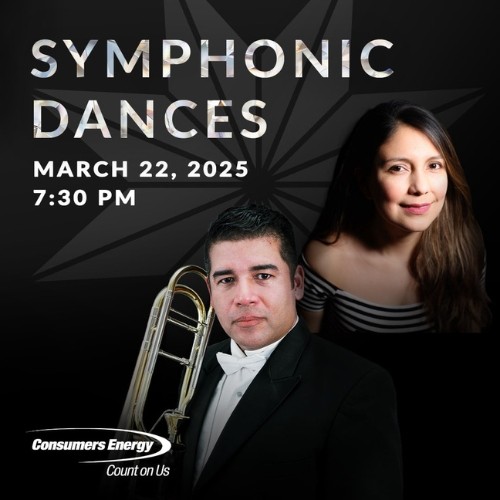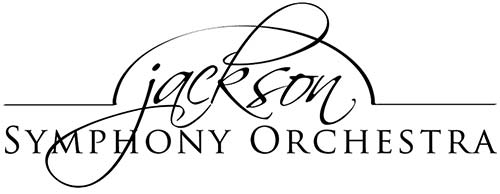

PROGRAM NOTES
SYMPHONIC DANCES
MARCH 22, 2025
On the Waterfront: Symphonic Suite | Leonard Bernstein (1955)
On the Waterfront (1954) is easily one of the most important of American films. Directed by the great—and controversial—Elia Kazan, with a screenplay by Budd Schulberg, and an all-star cast of Marlon Brando, Karl Malden, Lee J. Cobb, Rod Steiger, and Eva Marie Saint, it just doesn’t get much better than this in cinema. It won eight Academy Awards (but not one for the music!), and is almost always on the list of American top-ten movies. The film-score was composed when Bernstein was thirty-five, and is unique for the composer in that it was totally original, with no connections to any stage production. The story, about corruption and violence on the New Jersey docks, was unremittingly dark, and the composer’s music is eloquently reflective of it—perfect for a kind of “film noir.” The movie is in black and white, the sun never shines, and violence is always threatening. It’s all in the music, and makes for one of Bernstein’s masterpieces—it certainly set the mark for many following contemporary film scores.
The stark brass of the opening sets the mood perfectly. Later, this kind of writing comes back with even more power and dissonance; if it reminds one a bit of Copland’s Fanfare for the Common Man, is no accident. For it is no secret that Bernstein’s life-long musical style owed more than a little to the composer’s beloved mentor. Much of the score references Copland, but with a decided edge. Rhythmic displacements, jagged gestures, serene simple harmonies—it’s all there. Bernstein’s score is perfectly suited for the variety of dramatic situations of the film. The bleak scenes of the docks and the New Jersey tenements; the tender encounters between Brando and Saint; the serenity of the roof-top pigeon coops; the evil of Cobb; the moral ambiguity of Steiger; the firm morality of Malden; and the constant menace of real violence—all are subtly depicted without bathos, and with stylistic evenness. Like the best of film scores, the music is apt but not distracting.
Bernstein initially resisted accepting the commission for the score. Politically dedicated to liberal causes all of his life, he had deep antipathy for the director, Elia Kazan. Kazan was marginalized for many years for his coöperation with the McCarthy HUAC hearings. He named names in the witch-hunt. Musical posterity is fortunate that Bernstein saw the opportunity and changed his mind.
In many respects there is a cogent argument that the On the Waterfront Suite represents some of Bernstein’s very best work. Perhaps the Russian, Mstislav Rostropovich (of Slava! fame) said it best: “His Suite from On the Waterfront I have conducted many, many times, and this music smells of the United States. But, it is a good smell.”
Written by William E. Runyan.
Hojarasca | Carolina Calvache (2025)
EN
“Hojarasca” is a single-movement work for solo trombone and orchestra, inspired by my home country, Colombia, and the landscapes of Boonville, California, where I completed the piece. The idea for the first half of the piece took place in the summer of 2024 during a visit to my hometown, Cali. In the front yard of my parents’ home stands a beautiful, large tree. As I raked fallen leaves, I reflected on their life cycle—beginning vibrant and green, then transforming into a golden tapestry on the earth before aging into shades of brown. We admire trees when they bear fruit and bloom with beauty yet often overlook them when their leaves no longer flourish. But I wondered: what stories have these leaves witnessed before falling? How many whispered echoes of past seasons, tales of conquest, love, joy, and injustice do they hold?
The first half of the work draws from this metaphor of nature and human life—both in constant motion and evolution. Musically, the trombone embodies the hojarasca, narrating the leaves’ journey through vibrant and expressive melodies before they are carried away by the wind.
The second half of the piece shifts to a reflection on turbulence and hope. I was deeply moved by the book La Hojarasca (Leaf Storm) by Gabriel García Márquez, particularly its portrayal of war in Colombia’s past and the idea that history continues to cast shadows on the present. The music conveys the resilience and strength of the Colombian people, who have endured generations of conflict with unwavering spirit. This is expressed through dynamic percussion, rhythmic ostinatos, and melodic elements inspired by Colombian and Latin American folk Traditions.
The premiere of Hojarasca will take place on March 22, 2025, in Jackson, Michigan, conducted by Mathew Aubin, with Denis Jirón as the principal trombone soloist.
ES
“Hojarasca” es una obra de un solo movimiento para trombón solista y orquesta, inspirada en imágenes de mi país, Colombia, y los paisajes de Boonville, California donde compuse la mayor parte de la obra. La idea para la primera mitad de la pieza surgió en el verano de 2024 durante una visita a mi ciudad natal, Cali. En el jardín delantero de la casa de mis padres existe un árbol grande cuyas hojas se caen constantemente. Mientras recogía las hojas caídas, reflexioné sobre su ciclo de vida: comienzan vibrantes y verdes, luego en su ocaso forman la hojarasca cubriendo el suelo con una alfombra de colores dorados y marrones. Admiramos los árboles cuando dan frutos y florecen con belleza, pero a menudo los pasamos por alto cuando sus hojas dejan de prosperar. Me pregunté: ¿qué historias han presenciado estas hojas antes de caer? ¿Cuántos ecos susurrados de estaciones pasadas, relatos de conquista, amor, alegría e injusticia guardan en su memoria?
La primera mitad de la obra se basa en esta metáfora de la naturaleza y la vida humana, ambas en constante movimiento y evolución. Musicalmente, el trombón personifica la hojarasca, narrando el viaje de las hojas a través de melodías vibrantes y expresivas antes de ser arrastradas por el viento.
La segunda mitad de la pieza cambia hacia una reflexión sobre la turbulencia y la esperanza. Despues de leerme el libro La Hojarasca de Gabriel García Márquez, me conmovió profundamente su representación de la guerra en el pasado de Colombia y la idea de que la historia sigue proyectando su sombra en el presente. La música busca transmitir la resiliencia y fortaleza del pueblo colombiano, que ha soportado generaciones de conflicto con un espíritu inquebrantable. Esto se expresa en la música a través de la percusión, y el uso de ostinatos rítmicos y elementos melódicos inspirados en las tradiciones folclóricas de Colombia y América Latina.
El estreno de Hojarasca tendrá lugar el 22 de marzo del 2025 en Jackson, Michigan, bajo la dirección de Mathew Aubin, con Denis Jirón como trombonista solista.
Symphonic Dances, op.45 | Sergei Rachmaninoff (1940)
Those who create art, whether in the performing arts or in the visual arts, inevitably find their personal “niche” in matters of style. And it is of little consequence whether or not their artistic orientation is a conscious personal choice, or one seemingly imposed by their audiences and by professional critics. Simply put, there are artists whose voice naturally is to work within tradition and commonly-understood artistic language; they strive to develop that tradition to new levels of meaning through their own talent and personal vision. Others make a total commitment to artistic truth arrived at through new voices, new styles, new languages. Every museum and gallery of art, and every concert hall is testimony to this essential dichotomy. And it must be admitted, that there is a universal prejudice among intellectuals—especially those who subconsciously view the arts as they do technology—that the new is necessarily the good. The latest styles are more sophisticated, the thinking goes, hence more relevant, and old styles should be left with the dead artists that created them. This popular view was dominant among the cognoscenti during most of the twentieth century, but is beginning to moderate, as a more liberal acceptance of diverse artistic styles now is more common than previously—in all the arts.
Like J. S. Bach, who upon his death was looked upon as a more or less old fuddy-duddy (now we know better, of course), Rachmaninoff has borne his share of criticism for having composed in a hopelessly old-fashioned style, long after its relevance. His compositions are the last major representatives of vivid Russian Romanticism—long after that style was presumed dead and buried. Yet, like Bach, his musical genius, his talent, and his strong belief in the validity of his art all led him to create a legacy that took “old-fashioned-style” to a natural and valid high point of achievement. While a child of the nineteenth century, he died almost at the midpoint of the twentieth, secure in his success, and secure in the world’s enduring appreciation of his “dated” style. Although Rachmaninoff left Russia after the Revolution, never to return, and lived in a variety of places—at his death in 1943, he was living in Beverly Hills—he lived as a Russian all of his life. That is, he and his wife maintained a home with Russian servants, spoke Russian there, and lived with Russian customs.
His Symphonic Dances was his last composition, completed in 1940, and was composed while summering in Centerport, NY, a hamlet on the famed “Gold Coast” of Long Island. He spent time there to be near his brother, who was working at a well-known cancer research center nearby. Symphonic Dances was given its première by the Philadelphia Orchestra early in 1941. While true to his orientation to the late romantic idiom outlined above, his last work, nevertheless, shows evidence of an evolving sensitivity to progressive twentieth-century musical styles. While the three movements evince a clear and coherent musical style, they contain a wealth of references to a variety of musical and extra-musical elements. Moreover, while much of the traditional Rachmaninoff “sound” is prevalent, we hear new textures and harmonies not characteristic of the arch-romantic. Quotations from works that he had composed many decades before are interspersed with melodic elements from Russian ecclesiastical chant, modern, jagged rhythms, and even a solo for saxophone, of all things.
The first movement begins deceptively and coyly with a few quiet woodwind motifs over light tripping strings—and then hammer strokes from the full band sets the real mood. Memorable melodies one will not hear yet, for here, as in most of the movement, short little aphoristic motifs are the building blocks. From time to time the composer skillfully augments the percussion section with the piano. After establishing a steady rhythmic dance tempo, the middle section is introduced by a variety of delicate woodwind solos, working over an important, short motif. This prefaces the impressive, long lyrical solo for the alto saxophone, often in dialogue with its friends in the woodwind section—the first characteristic Rachmaninoff tune of the movement. The string section then picks up the soulful saxophone tune and spins it out in the composer’s familiar style. A soft, ominous transition in the low instruments takes us back to the opening tempo, motifs, and mood. Before this return finishes the movement, there’s an odd moment where an apparently new “big lyrical Rachmaninoff tune” seemingly appears out of nowhere. This beautiful tune is actually a brief quotation from his disastrous first symphony from 1895. The condemnation of it was so severe (“. . . from the conservatory of Hell.”) that Rachmaninoff suffered a psychological breakdown. So, forty-five years later, in old age, he is apparently thumbing his nose at long dead critics. The movement goes from this to end quietly.
The middle movement is a dark, introspective waltz in the tradition of Sibelius’ famed Valse triste. Rarely loud, always gently swaying, it’s a dark affair with frequent ruminative suspensions of the tempo. The spectral mood is established by muted brass, soft cascades of woodwind scales against the sotto voce strings, and even a “Devil’s fiddle” evocation. Rachmaninoff originally entitled this movement “Dusk,” and the crepuscular atmosphere of the music perfectly captures the moment.
The last movement is much more than just the third dance; it’s a full-blown symphonic movement in the form of a dynamic scherzo. After a brief, slow introduction with mysterious chords in the winds, the driving scherzo bursts forth, with a dash of “ecclesiastical” chimes foretelling something of the nature of the coming contest. Fundamentally, the movement is built around a contrast between death and immortal life, but it’s not always a dark affair. The musical material of death is the familiar Dies iræ from the Requiem Mass, and Rachmaninoff uses the chant from the discovery of the empty tomb on Easter from his beloved Vespers as the affirmation of life. Of course, the movement builds on all this, but these are the basic materials from which the composer weaves a stunning, expansive movement. The tempos, the moods, modes—major and minor, and orchestration: all is a kaleidoscope of symphonic proportions. The slow middle contrasting section usual to scherzos begins with dark presentiments, but soon grows into an affirmative, soaring affair so familiar in Rachmaninoff’s music. A little fanfare in the oboes heralds the return of the driving scherzo as the motifs of death and life continue their struggle. A smashing conclusion carried by the composer’s mastery of huge sonic canvases of orchestral color and driving rhythms is inevitable. When one considers the life’s work of Rachmaninoff, a more fitting last composition cannot be imagined.
Written by William E. Runyan.
PROGRAM SCHEDULE
Leonard Bernstein
On the Waterfront: Symphonic Suite <1955>
Carolina Calvache
Hojarasca – World Premiere <2025>
Sergei Rachmaninoff
Symphonic Dances, op.45 <1940>
| RUNTIME: 1H 45M |
